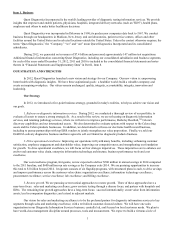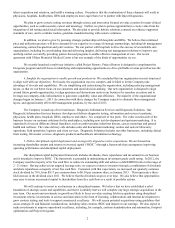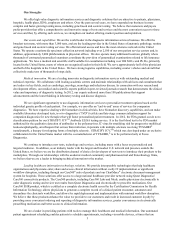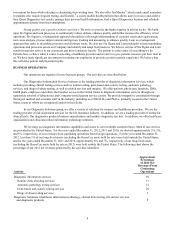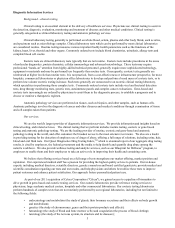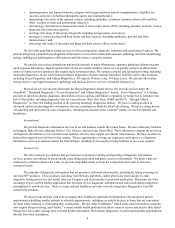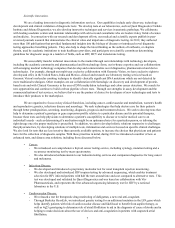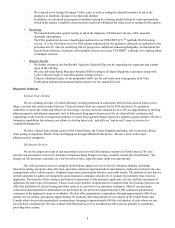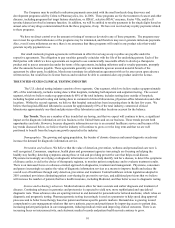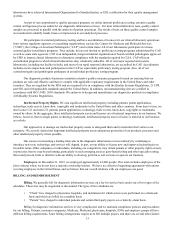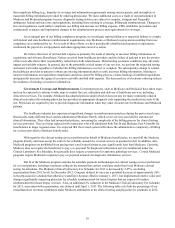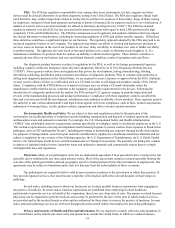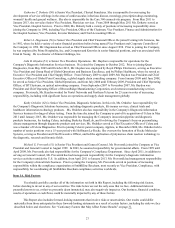Quest Diagnostics 2012 Annual Report Download - page 14
Download and view the complete annual report
Please find page 14 of the 2012 Quest Diagnostics annual report below. You can navigate through the pages in the report by either clicking on the pages listed below, or by using the keyword search tool below to find specific information within the annual report.11
Customers and payers. Our customers and payers, including physicians, health insurance plans, IDNs, employers,
pharmaceutical companies and others, have been consolidating and diversifying. For example, an increased number of hospital
systems are considering establishing or have established health insurance plans, and health insurance plans increasingly are
considering providing or are providing healthcare services. Consolidation is increasing pricing transparency and bargaining
power, enhancing purchasing sophistication and encouraging internalization of clinical testing. Physicians increasingly are
employed by hospital systems or large group practices integrated with healthcare systems, instead of organizing physician-
owned practices, which is changing the dynamics for whether clinical testing is performed by a hospital or a non-hospital.
Patient-centered medical homes are increasingly being established to deliver patient care. In addition, federal healthcare reform
legislation adopted in 2010 encourages the formation of accountable care organizations and requires implementation of health
insurance exchanges, which may result in changes in the way that some healthcare services are purchased and delivered in the
United States.
Competition. The clinical testing industry remains fragmented, is highly competitive and is subject to new
competition. Competition is growing from non-traditional competitors. Increased hospital acquisitions of physician practices
enhance physician ties to hospital-affiliated laboratories and may strengthen their competitive position. New industry entrants
with extensive resources may make acquisitions or expand into our traditional areas of operations.
Reimbursement pressure. There is a strong focus in the United States on controlling the overall cost of healthcare.
Healthcare market participants, including governments, are focusing on controlling costs, including potentially by changing
reimbursement for healthcare services (including but not limited to a shift from fee for service to capitation), revising test
coding, changing medical coverage policies (e.g., healthcare benefits design), pre-authorization of lab testing, requiring co-
pays, introducing lab spend management utilities and payment and patient care innovations such as accountable care
organizations and patient-centered medical homes. While pressure to control healthcare costs poses a risk to our Company, it
creates an opportunity for increased utilization of testing as an efficient means to manage the total cost of healthcare. We
believe that it also creates opportunities for low-cost providers, like our Company, as compared to other providers.
Healthcare Utilization. In the past few years, growth in healthcare utilization in the United States has slowed. There
may be many factors contributing to this result, including sluggish employment growth, benefit plans imposing higher levels of
patient responsibility, under-employment in the work force and patients delaying medical care.
Legislative, regulatory and policy environment. Government oversight of and attention to the healthcare industry in
the United States is significant and increasing; healthcare payment reform is a top issue. The FDA has announced several
regulatory and guidance initiatives that may impact the clinical laboratory testing business, including by increasing regulation
of LDTs and analyte specific reagents. If finalized, these initiatives could have a significant impact on our business. Federal
healthcare reform legislation adopted in 2010 has created significant uncertainty as healthcare markets react to potential and
impending changes. For example, states may opt out of Medicaid expansion and employers may discontinue offering group
health insurance to their employees, shifting more people to exchange products.
Globalization. There is a growing demand for healthcare services in emerging market countries. Opportunities are
arising to participate in the restructuring or growth of the healthcare systems in these countries. Additionally, our customers are
establishing positions outside the United States. Demographic changes globally also may create opportunities.
Customers and Payers. We provide diagnostic information services to a broad range of customers who order such
services, including physicians, hospitals, IDNs and employers. In many cases, the customer that orders the services is not
responsible for the payments for services. Depending on the billing arrangement and applicable law, the payer may be (1) a
third party responsible for providing health insurance coverage to patients, such as a health insurance plan, self-insured
employer benefit fund, an accountable care organization, a patient-centered medical home or the traditional Medicare or
Medicaid program, (2) the patient or (3) the physician or other party (such as a hospital, another laboratory or an employer)
who send the testing to us.
Health Plans. Health plans, including managed care organizations and other health insurance providers, typically
reimburse us as a contracted provider on behalf of their members for diagnostic information services performed.
Reimbursement from our five largest health plans totaled less than 20% , and no one health plan accounted for 10%, of our
consolidated net revenues in 2012.
Health plans typically negotiate directly or indirectly with a number of diagnostic information services providers, and
represent approximately one-half of our total clinical testing volumes and one-half of our net revenues from diagnostic
information services. The trend of consolidation among health plans has continued. In certain locations, such as California,


